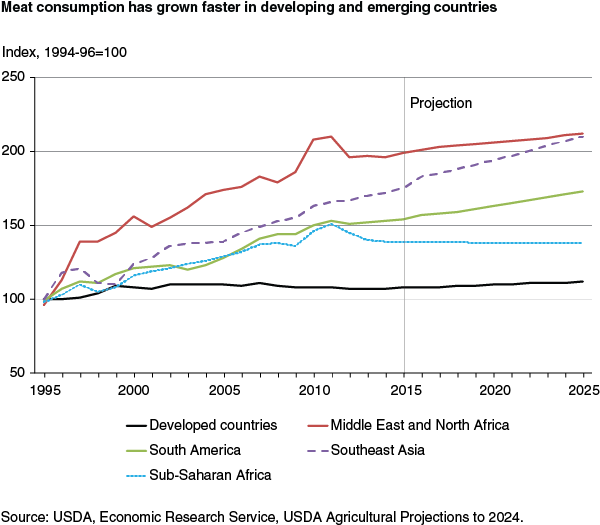Growth in Meat Consumption for Developing and Emerging Economies Surpasses That for the Developed World
- by Getachew Nigatu and Ralph Seeley
- 7/6/2015
Per capita meat consumption for beef and veal, pork, and poultry has grown around 3 percent annually in developing and emerging economies (DEE) since the mid-1990s, while growth has been only about 0.4 percent for developed countries. The greatest increase in per capita meat consumption is in the Middle East and North Africa (MENA), followed by Southeast Asia and South America. For the MENA region, per capita meat consumption has doubled since the mid-1990s, from 12 to 24 kilograms (kg), mainly reflecting gains in poultry. In Southeast Asia and South America, meat consumption per capita has increased from 10 to 18 kg, and from 55 to 85 kg, respectively. In contrast, per capita meat consumption in developed countries, while higher than in the DEE, has increased by a smaller amount, from 86 to 92 kg.
The various regions of the DEE are the main sources of projected growth for meat and feed demand, leading to projected increases in global trade for these commodities. Important factors for such growth are increasing incomes and urbanization along with an expanding middle class, implying that a greater percentage of the population can afford to consume meat and gain access to meat markets. These factors can change consumption patterns and preferences away from traditional food sources and staples toward greater diet diversification and higher quality protein from meat.
To meet the growing meat and feed products demand, the DEE is projected to both increase meat production and import more feed products and meat. Producing more meat requires expansion of feed grain production, and hence, the amount of cropland would likely be expanded. If projected increases in meat production are unable to meet future demand, countries will likely either import more feed to expand meat production or import more meat products. The increased import demands for feed and meat could increase global prices.
Given that two-thirds of the world’s population lives in the DEE, with its relatively faster population and income growth, potential opportunities to increase exports exist for major meat and feed producing countries such as the United States.
This article is drawn from:
- Westcott, P. & Hansen, J. (2015). USDA Agricultural Projections to 2024. U.S. Department of Agriculture, Economic Research Service. OCE-151.


